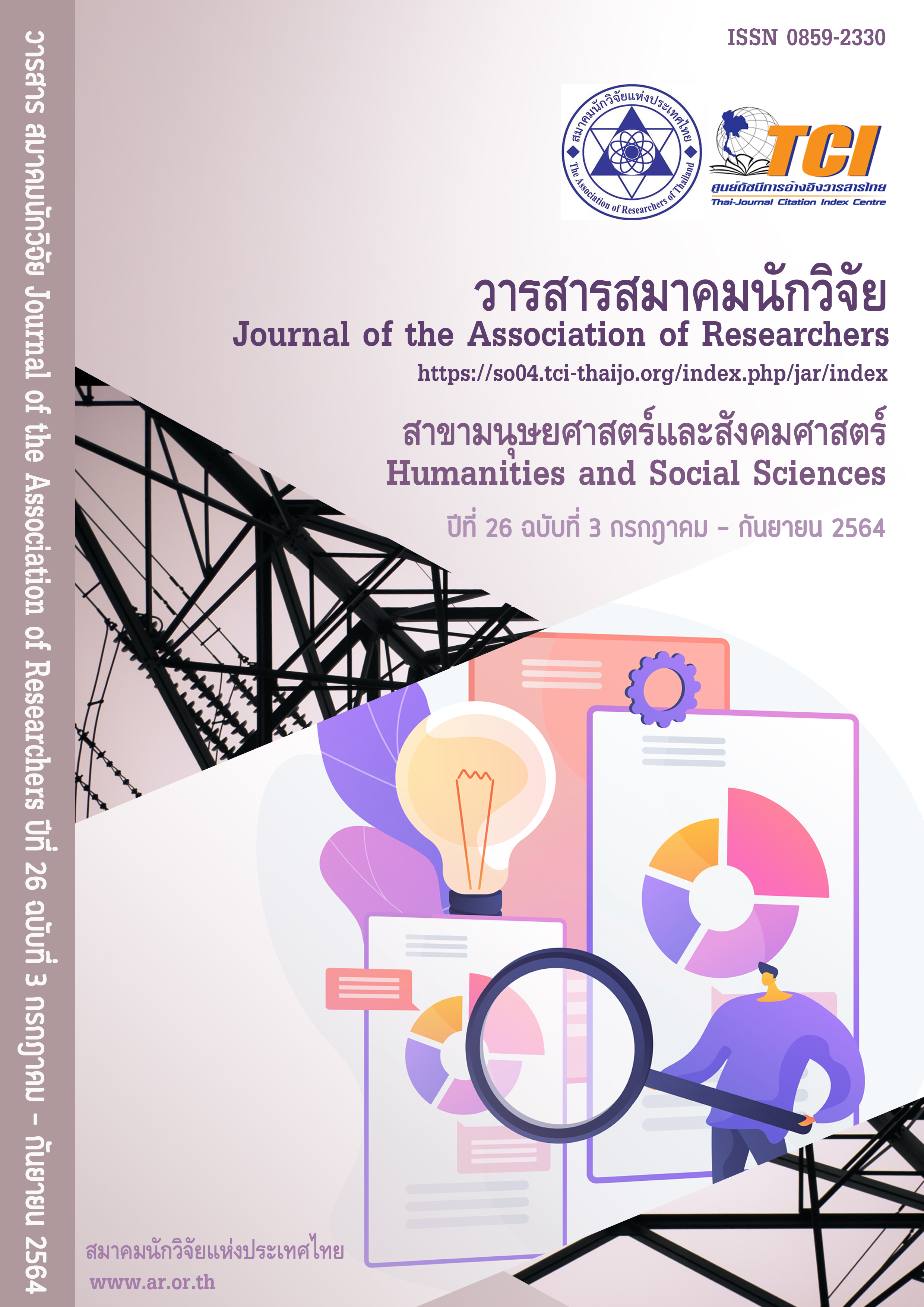Healthy WorkPlace and Human Resource Management in Chandrakasem Rajabhat University
Main Article Content
Abstract
The purpose of this research was to study the factors of healthy organization related to working happiness of the personnel of Chandrakasem Rajabhat University. To propose to the executives to use as a benefit in improving the human resource management system for personnel to be happy in their work. The samples used in the research were administrators, faculty members, and staff. The tool used to collect data was a questionnaire to assess readiness to lead the university to be a healthy organization. The statistics used to analyze the data are frequency, mean, percentage, and standard deviation. Research results of health organization and human resource management leading to the healthy organization of Chandrakasem Rajabhat University Overall, all aspects were at a high level. Human Capital Development, Training, Welfare, Working Environment, Performance Management, Employee Relation, Compensation & Benefit, and Viewpoint of Thinking will be the cause of making employees happy at work and the feeling to the university. Especially the most viewpoint that results in the employees being happy at work the most is the working atmosphere. The personnel are happy with their colleagues who help each other, have friendship and sincerity with each other. This makes the staff feel that the university is their second home in life. The most feeling to the university is loyalty, love, and want to do the best work in return for the merit of the university. Exceptional for welfare, it appeared to be at a moderate level. When considering the particular details of welfare benefits in detail, it was found that the personnel's opinion was that the readiness was at the moderate level, the lowest level is basic welfare such as the convenience and speed of request for using a vehicle. And the arrangement of a standard canteen. In summary, the management should improve the welfare because it is an incentive motivation that can persuade personnel to join and also make more benefit to the university in the long term.
Article Details
บทความที่ปรากฏในวารสารนี้ เป็นความรับผิดชอบของผู้เขียน ซึ่งสมาคมนักวิจัยไม่จำเป็นต้องเห็นด้วยเสมอไป การนำเสนอผลงานวิจัยและบทความในวารสารนี้ไปเผยแพร่สามารถกระทำได้ โดยระบุแหล่งอ้างอิงจาก "วารสารสมาคมนักวิจัย"
References
กฤติน กุลเพ็ง. (2560). การบริหารจัดการทรัพยากรมนุษย์ ยุค 4.0 : นนทบุรี : IOD Consulting and
Training, 2560
ขวัญเมือง แก้วดำเกิง. (2556). แนวคิดการสร้างองค์กรแห่งความสุข (Happy workplace). เข้าถึงได้จาก
http://hq.prd.go.th/plan/ewt_dl_link.php?nid=2127.
ชวนชม ชินะตังกรู,ศิริชัยและคณะ (2560). ความสุขในการทำงานของบุคลากรการศึกษา,
วารสารศิลปากรศึกษาศาสตร์วิจัย, 9 (2) 26-39
ภาณุภาคย์ พงศ์อติชาต. (2550). สมดุลระหว่างชีวิตกับการทำงาน : เรื่องจริงหรือแค่อิงนิยาย. การเสริมสร้าง
คุณภาพชีวิตและการทำงาน กระแสใหม่ของการบริหารทรัพยากรบุคคล.
ชาญวิทย์ วสันต์ธนารัตน์. (2556).องค์กรแห่งความสุข (Happy workplace). เข้าถึงได้จากhttp://mrs laongtip.wordpress.com/2013/09/11/ องค์กรแห่งความสุข-happy-workplace.
รุ่งนภา ชุณหวรชัย. (2556). แนวทางการพัฒนาองค์กรแห่งความสุข “คึกฤทธิ์อาร์คิเทค” วิทยานิพนธ์
บริหารธุรกิจมหาบัณฑิต, สาขาบริหารธุรกิจ , วิทยาลัยบัณฑิตศึกษาการจัดการ,มหาวิทยาลัยขอนแก่น.
จินดารัตน์ โพธิ์นอก. (2557). องค์กรแห่งความสุข.เข้าถึงได้จาก http://www.dailynews.co.th/article/217512
http://www.dailynews.co.th/article/217512). (in Thai).
ยุพาวรรณ ทองตะนุนาม, และคณะ (2558). ปัจจัยพัฒนาองค์การแห่งความสุข (ภาครัฐ) : การทบทวนวรรณกรรม
อย่างเป็นระบบ, Journal of Health Science Research. 9 (1). 52-62
นรีนาถ กาญจนเจตนี. (2560). กระบวนการบริหารทรัพยากรมนุษย์กับความสุขในการทำงาน : กรณีศึกษากรม
หม่อนไหม กระทรวงเกษตรและสหกรณ์, วิทยานิพนธ์ หลักสูตรวิทยาศาสตรมหาบัณฑิต (การพัฒนา
ทรัพยากรมนุษย์) คณะพัฒนาทรัพยากรมนุษย์, สถาบันบัณฑิตพัฒนบริหารศาสตร์.
ธารณ์ ทองงอก. (2552). ความสุขและความต้องการความสุขในการทำงานของบุคลากรในสำนักการศึกษา เมือง
พัทยา จังหวัดชลบุรี. งานนิพนธ์การศึกษามหาบัณฑิต,สาขาวิชาการบริหารการศึกษา, คณะศึกษาศาสตร์
,มหาวิทยาลัยบูรพา.
พิกุล พุ่มช้าง,และปริญญา มีสุข, (2560). การวิเคราะห์องค์ประกอบการเป็นองค์การแห่งความสุขของ
สถาบันการศึกษาไทย, วารสารฉบับภาษาไทย สาขามนุษยศาสตร์ สังคมศาสตร์ และศิลปะ 10 (2).647-663
สำนักงานกองทุนสนับสนุนการสร้างเสริมสุขภาพ, (2552).รายงานประจำปี 2552 สำนักงานกองทุนสนับสนุนการ
สร้างเสริมสุขภาพ (สสส.)
สำนักวิจัยเอแบคโพลล์ มหาวิทยาลัยอัสสัมชัญ, (2551).สืบค้น 10 มิถุนายน 2564จาก https://www.ryt9.com
/s/abcp/506378
อาภรณ์ ภู่วิทยพันธุ์. (2553). เครื่องมือการพัฒนาบุคลากรด้วย “การฝึกอบรมในขณะปฏิบัติงาน”. สืบค้นวันที่ 5
มิถุนายน 2553, จาก http://www.peoplevalue.co.th/.
Buton J. (2010). WHO Healthy Workplace Framework and Model: Background and Supporting
Literature and Practices. WHO Headquarters, Geneva, Switzerland.
Krejcie R.V. and Morgan, D.W. (1970). “Determining sample size for research activities.” Journal
of Education and Psychological Measurement. (3) : 607-610.
Translated Thai References
ABAC Poll Research Office Assumption University, (2008). (in Thai).
Chinatangkru, C., Chinatangkru, S., & Dejbamrung, S. (2017). Happiness at Work
of Educational Personnel, Silpakorn Education Research Journal, Vol. 9, No. 2 (July-
December). (in Thai).
Choonhaworachai, R. (2013). Guidelines for the development of the organization of happiness.
“Kukrit Architect” Master of Business Administration Thesis, Business Administration, Grad
uate School of Management, Khon Kaen University). (in Thai).
Kaewdamkoeng, K. (2013). The concept of creating a happy organization (Happy workplace).
Accessed from: http://hq.prd.go.th/plan/ewt_dl_link.php?nid=2127). (in Thai).
Kanchanajatanee, N. (2017). Human resource management process and happiness at
work : a case study of the Department Mulberry Silk, Ministry of Agriculture and
Cooperatives, Thesis, Master of Science Program (Development Human Resources)
Faculty of Human Resource Development, National Institute of Development
Administration. (in Thai).
Kulpeng, K. (2017). Human Resource Management 4.0 : Nonthaburi : IOD Consulting and
Training, 2017 (in Thai).
Pongatichart, P. (2007). The balance between life and work : Fact or just based on fiction.
enhancing the quality of life and work The new wave of human resource management. Office of the Civil Service Commission.. Bangkok : Airborne Print Co., Ltd). (in Thai).
Thai Health Promotion Foundation, (2009). (in Thai).
Phuwittayaphan, A. (2010). Human resource development tools too. “Training while
working”. Retrieved June 5, 2010, from http://www.peoplevalue.co.th/). (in Thai).
Phonok, C. (2014). Happiness organization.Access from : http://www.dailynews.co.th/article/217512). (in Thai).
Phuwittayaphan, A. (2007). Strategies for management and development of outstanding
employees. Retrieved April 1, 2021 from http://www.hrcenter.co.th/column_detail.php ?column_id=603&page=1). (in Thai).
Personnel Management Division Chandrakasem Rajabhat University on October 2, 2020). (in Thai)
Pumchang, P., Meesuk, P. (2017). Factor Analysis of Happy of Thai Education
Institutions, Thai edition journal Humanities, Social Sciences and Arts, Year 10, No. 2 May
– August 2017). (in Thai).
Thepchit, S. & Thawiphaiboonwong, J. (2014). Suk Kan Ra Rao (HR Care Meter). First Edition.
Bangkok: Have Idea Co., Ltd). (in Thai).
Thongngok, T. (2009). Happiness and the need for happiness in the work of personnel in
the City Education Office. Pattaya, Chonburi Province. Master's Degree Thesis,
Department of Educational Administration, Faculty of Education, Burapha University). (in
Thai).
Thongtanunam, Y. et al.(2015). Factors associated with happy workplace (public sector
organization) : A systematic review, Journal of Health Science Research.9(1) 52-62 (in Thai).
Wasanthanarat, C. (2013). Happy workplace. Access from : http://mrslaongtip.wordpress.com /2013/09/11/. (in Thai).


